モーションコントロール市場:現状分析と予測(2024~2032年)
オファリング(アクチュエータおよび機械システム、ドライブ、モータ、モーションコントローラ、センサおよびフィードバックサービス、ソフトウェアおよびサービス); システム(オープンループシステムおよびクローズドループシステム); 業界(航空宇宙および防衛、自動車、金属・機械製造、ヘルスケア、半導体およびエレクトロニクス、その他); および地域/国別の重点
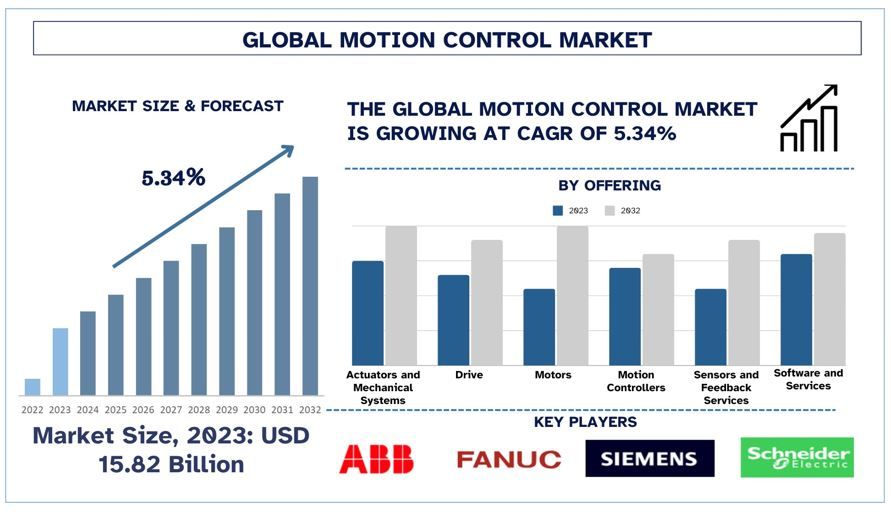
モーションコントロール市場規模と予測
2023年のモーションコントロール市場は、約158.2億米ドルの価値があり、様々な業界におけるオートメーションとエネルギー効率の高いソリューションへの需要の高まりにより、予測期間(2024~2032年)中に約5.34%の力強いCAGRで成長すると予測されています。
モーションコントロール市場分析
モーションコントロールは、回転および直線アクチュエータを使用して機械の動きを行うメカニズムです。これは、位置または速度の機械が電気モーター、リニアアクチュエータ、油圧ポンプ、またはサーボモーターなどのデバイスの助けを借りて制御されるオートメーションプロセスのサブフィールドです。モーションコントロールは、組織がその一貫性を高め、生産レベルを向上させ、高速で高い精度を提供し、コスト最適化につながるのに役立ちます。
モーションコントロール市場は、エネルギー使用量の増加を通じて製造精度と効率の向上が求められているため、約5.34%の安定した成長率で成長すると予想されています。また、労働コストを相殺するために企業が効率を求めているため、モーションコントロールシステムを内蔵した協働ロボット(コボット)の需要も高まっています。しかし、持続可能性と厳格なエネルギー使用への傾向の高まりは、特に電気自動車の製造プロセスにおいて、多くのロボットプロセスが高レベルの精度を必要とするため、モーションコントロールシステムの導入を後押ししています。
市場における最近の動向:
- 2024年2月、ABBは、超プレミアムエネルギー効率と非常に効果的な液体冷却の利点を組み合わせた新バージョンを発売し、世界初のIE5 SynRM(同期リラクタンスモーター)シリーズを発表しました。この新しい設計は、コンパクトなフットプリントで高出力と信頼性の新しいベンチマークを設定します。新しく発売されたモーターは、より効率的で信頼性が高く、より少ないエネルギー消費を通じて総所有コスト(TCO)を最適化します。
- 2022年6月、シーメンスはSenseyeを買収し、予測保全と資産インテリジェンスのポートフォリオを拡大しました。この買収の助けを借りて、シーメンスは機械の将来の状態を判断することができ、業界全体のお客様を支援し、全体的な機器の有効性を高めることができます。
モーションコントロール市場トレンド
IoTとスマートシステムの導入
IoTとスマートシステムの導入は、モーションコントロール市場における主要なトレンドの1つです。このトレンドは、業界全体の製造プロセスに革命をもたらし、生産ラインの効率を向上させました。これらのテクノロジーの統合により、リアルタイムモニタリングと予測保全の助けを借りて、時間通りに課題を克服することができます。
- 2024年4月、シーメンスは、Siemens Xceleratorの一環として、Simatic S7-1200 G2と呼ばれる新世代のコントローラを発売しました。このセンス形成コントローラシリーズを導入することにより、シーメンスは製品ポートフォリオを拡大するだけでなく、オートメーションとプログラミングの簡素化に関して、これらの最新の進歩が顧客にもたらす可能性を示しています。これは、モーションコントロールの基本的なメリット、あらゆる機械の安全性の容易な実装、高いパフォーマンス、およびスケーラビリティを通じて実現されています。
- 2024年6月、ABBは、OmniCoreと呼ばれる次世代ロボット制御プラットフォームを発売しました。このプラットフォームは、より速く、より正確で、より自律的なオートメーションを通じて、ビジネスの生産性と柔軟性を向上させるために発売されました。このプラットフォームは、1億7000万米ドルの総投資の結果であり、業界をさらにオートメーションへと推進しています。
これらの革新は、より高い効率とスループットを向上させ、ダウンタイムを減らし、メーカーのプロセス制御を改善しています。モーションを制御するIoTおよびスマートシステムのこれらの新しいテクノロジーは、インダストリー4.0と呼ばれる変化する製造業と調和しています。
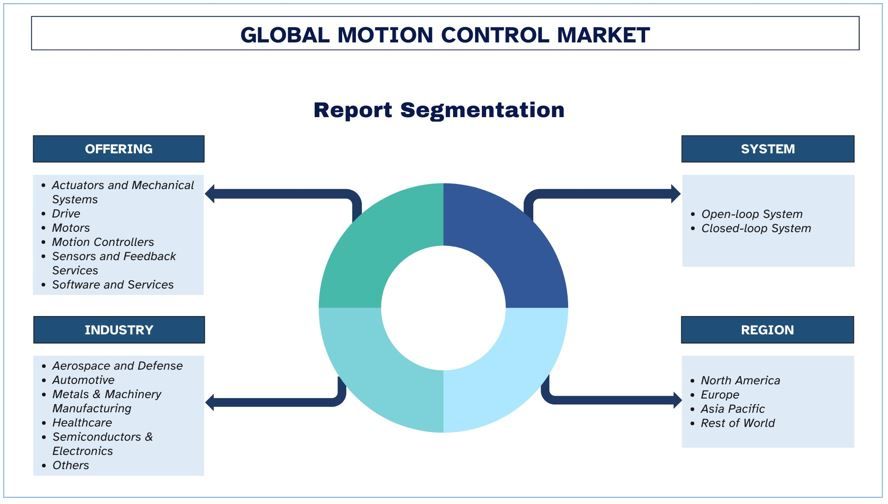
アジア太平洋地域は、予測期間中に市場を支配すると予想されます
アジア太平洋地域は、新興製造ハブであるなど、さまざまな要因により、2023年に市場の大半のシェアを占めました。安価な人件費による最大の製造企業の存在や、並行して成長するイノベーションなどの要因が市場の成長を支えました。中国、インド、インドネシア、韓国などの国々は、バッテリー管理システム、ドライブ、モーターなど、幅広い自動車部品を製造しています。これらの部品には、効率的で信頼性の高いモーターが必要であり、その結果、モーションコントロール市場を牽引しています。インドの自動車および自動車部品に対するPLIスキームなど、重工業省傘下の政府支援は、機械の生産を後押しし、オートメーションとロボット工学の導入をさらに増加させ、したがってモーションコントロール市場を牽引しています。たとえば、2023年には、IFR(国際ロボット連盟)が発表したレポートによると、世界中の工場に合計553,052台の産業用ロボットが設置される予定です。そのうち、新たに導入されたロボットの73%がアジアに設置されました。これにより、この地域でのモーションコントロールの需要が高まり、グローバル市場を支配する最も重要な要因の1つとなっています。日本は、ホンダ、トヨタ、日産などのグローバルな自動車メーカーが存在し、自動車産業の面で最も技術的に進んだ国の1つです。これにより、メーカーはプロセスを最適化し、日常的な費用を削減する技術的に高度なソリューションを設置できます。これを達成するために、企業はモーションコントロール市場を牽引するロボットメカニズムまたはコボットを設置する必要があります。さらに、JAMA(日本自動車工業会)が発表したレポートによると、製造業の増加に伴い、同国の自動車出荷台数は2022年に63兆円に達し、前年から11.4%増加しました。さらに、同国は2023年に輸出を4,422,682台に増加させました。自動車の輸出は、2023年には北米(172万台)、ヨーロッパ(775,100台)、中東(490,000台)、オセアニア(469,000台)、ラテンアメリカ(277,000台)に増加しましたが、アジア(575,000台)とアフリカ(107,000台)には減少しました。自動車の生産と輸出の増加は、市場の需要を押し上げました。
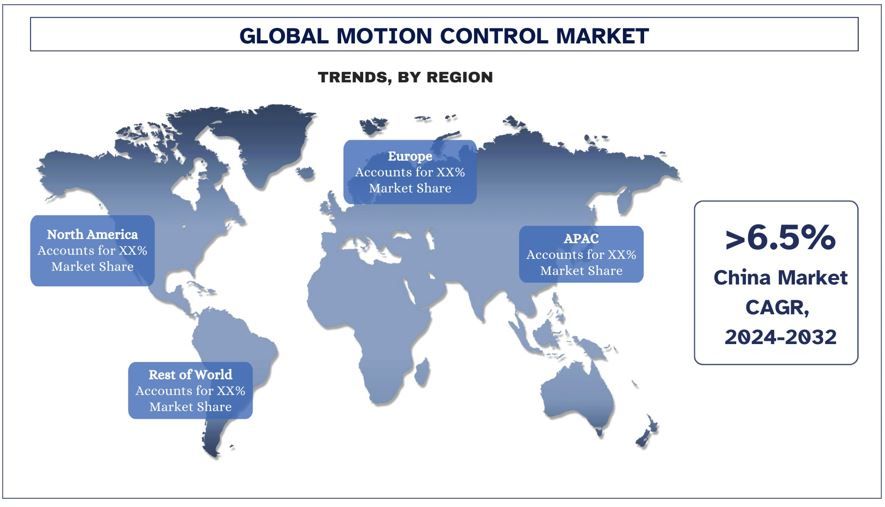
モーションコントロール業界の概要
モーションコントロール市場は競争が激しく、複数のグローバルおよび国際的な市場プレーヤーが存在します。主要なプレーヤーは、パートナーシップ、合意、コラボレーション、地理的拡大、合併、買収など、市場プレゼンスを高めるためのさまざまな成長戦略を採用しています。市場で事業を展開している主要なプレーヤーには、ABB、FANUC CORPORATION、シーメンス、Schneider Electric、Rockwell Automation、Parker Hannifin Corporation、Bosch Rexroth Corporation、OMRON Corporation、三菱電機株式会社、STMicroelectronicsなどがあります。
- 2024年1月、シーメンスは、より広範なアプリケーション分野向けに、新しいハードウェアとソフトウェアの点でSinamics S210サーボドライブシステムを強化しました。新しいV6ソフトウェア世代の最新機能には、コントローラの負荷を軽減するシングルポジショナと、サードパーティ製コントローラの統合用のEtherNet/IPインターフェースが含まれます。サーボドライブシステムは、50 W~7 kWの電力範囲で高いダイナミクスが要求されるアプリケーションに特に適しています。たとえば、包装機械、ピックアンドプレース機械、デジタルプリンター、またはあらゆる自動化されたデバイスなどです。
モーションコントロール市場レポートの範囲
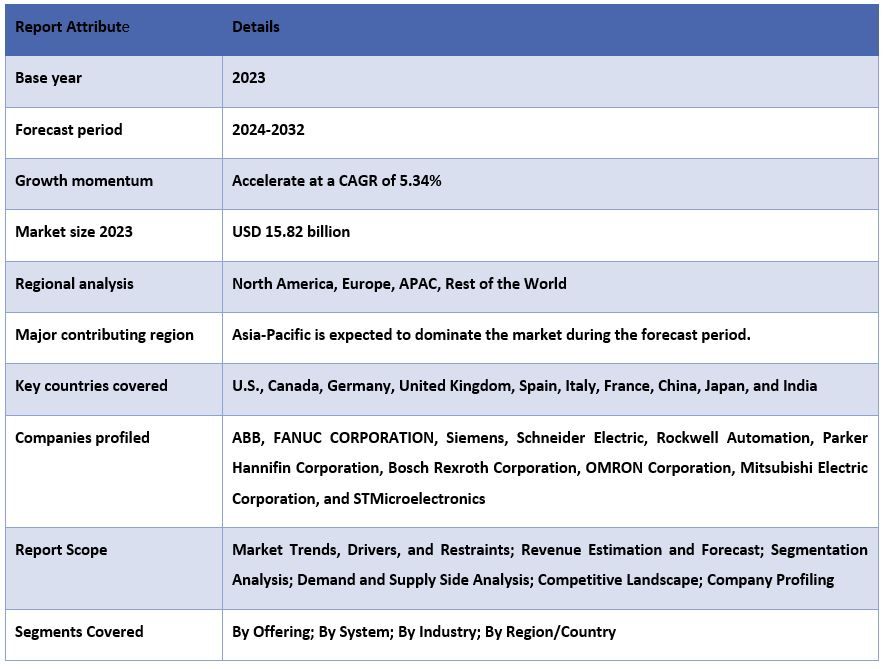
このレポートを購入する理由:
- この調査には、認証された主要な業界専門家によって検証された市場規模と予測分析が含まれています。
- このレポートは、全体的な業界のパフォーマンスの迅速なレビューを1つで提示します。
- このレポートは、主要なビジネス財務、製品ポートフォリオ、拡張戦略、および最近の動向に重点を置いて、主要な業界関係者の詳細な分析をカバーしています。
- 業界で蔓延する推進要因、抑制要因、主要なトレンド、および機会の詳細な検討。
- この調査では、さまざまなセグメントにわたる市場を包括的にカバーしています。
- 業界の詳細な地域レベルの分析。
カスタマイズオプション:
グローバルモーションコントロール市場は、要件またはその他の市場セグメントごとにさらにカスタマイズできます。これらに加えて、UMIは、お客様独自のビジネスニーズを理解しているため、お客様の要件に完全に適合するレポートを入手するために、お気軽にお問い合わせください。
目次
モーションコントロール市場分析(2024~2032年)の調査方法
歴史的な市場の分析、現在の市場の推定、および世界のモーションコントロール市場の将来の市場の予測は、主要な地域におけるモーションコントロールの導入を作成および分析するために行われた3つの主要なステップでした。歴史的な市場数値を収集し、現在の市場規模を推定するために、徹底的な二次調査が実施されました。次に、これらの洞察を検証するために、多数の調査結果と仮定が考慮されました。さらに、世界のモーションコントロール市場のバリューチェーン全体にわたる業界専門家との徹底的な一次インタビューも実施されました。一次インタビューによる市場数値の仮定と検証の後、トップダウン/ボトムアップアプローチを採用して、完全な市場規模を予測しました。その後、市場の内訳とデータ三角測量方法を採用して、業界のセグメントおよびサブセグメントの市場規模を推定および分析しました。詳細な方法論は以下に説明します。
過去の市場規模の分析
ステップ1:二次情報源の詳細な調査:
年間報告書と財務諸表、パフォーマンスプレゼンテーション、プレスリリースなどの企業内部の情報源、ジャーナル、ニュースと記事、政府出版物、競合他社の出版物、セクターレポート、サードパーティデータベース、その他の信頼できる出版物などの外部情報源を通じて、モーションコントロール市場の過去の市場規模を取得するために詳細な二次調査が実施されました。
ステップ2:市場セグメンテーション:
モーションコントロール市場の過去の市場規模を取得した後、主要地域のさまざまなセグメントとサブセグメントの過去の市場洞察とシェアを収集するために詳細な二次分析を実施しました。オファリング、システム、業界、地域など、主要なセグメントがレポートに含まれています。その地域におけるテストモデルの全体的な導入を評価するために、国レベルの分析がさらに実施されました。
ステップ3:要因分析:
さまざまなセグメントとサブセグメントの過去の市場規模を取得した後、モーションコントロール市場の現在の市場規模を推定するために詳細な要因分析を実施しました。さらに、モーションコントロール市場のオファリング、システム、業界、地域などの従属変数と独立変数を使用して要因分析を実施しました。世界中のモーションコントロール市場セクターにおけるトップパートナーシップ、合併、買収、事業拡大、製品発売を考慮して、需要と供給側のシナリオの徹底的な分析が実施されました。
現在の市場規模の推定と予測
現在の市場規模の算出:上記の3つのステップからの実用的な洞察に基づいて、現在の市場規模、世界のモーションコントロール市場の主要プレーヤー、およびセグメントの市場シェアに到達しました。必要なすべてのパーセンテージシェア分割と市場の内訳は、上記の二次アプローチを使用して決定され、一次インタビューを通じて検証されました。
推定と予測:市場の推定と予測のために、推進要因とトレンド、抑制要因、および関係者が利用できる機会を含むさまざまな要因に重みが割り当てられました。これらの要因を分析した後、適切な予測手法、つまりトップダウン/ボトムアップアプローチを適用して、グローバルな主要市場全体のさまざまなセグメントおよびサブセグメントについて2032年の市場予測に到達しました。市場規模を推定するために採用された調査方法には以下が含まれます。
- 国内の主要市場における収益(USD)とモーションコントロール市場の導入率という点で、業界の市場規模。
- 市場セグメントおよびサブセグメントのすべてのパーセンテージシェア、分割、および内訳。
- 提供される製品の観点からの世界のモーションコントロール市場の主要プレーヤー。また、この急成長市場で競争するためのこれらのプレーヤーが採用した成長戦略。
市場規模とシェアの検証
一次調査:主要地域全体で、トップレベルのエグゼクティブ(CXO/VP、セールスヘッド、マーケティングヘッド、オペレーショナルヘッド、リージョナルヘッド、カントリーヘッドなど)を含むキーオピニオンリーダー(KOL)との詳細なインタビューが実施されました。一次調査の結果を要約し、統計分析を実行して、述べられた仮説を証明しました。一次調査からのインプットは二次的な知見と統合され、情報を実用的なインサイトに変換しました。
異なる地域における主要参加者の分割
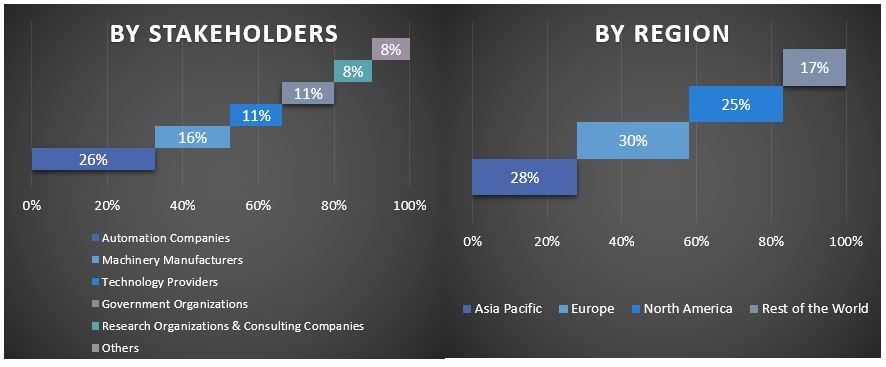
市場エンジニアリング
データ三角測量技術を採用して、全体的な市場推定を完了し、世界のモーションコントロール市場の各セグメントとサブセグメントの正確な統計数値を導き出しました。提供、システム、業界、および世界のモーションコントロール市場の地域におけるさまざまなパラメータとトレンドを調査した後、データはいくつかのセグメントとサブセグメントに分割されました。
グローバルモーションコントロール市場調査の主な目的
グローバルモーションコントロール市場の現在および将来の市場トレンドは、この調査で特定されました。投資家は、この調査で実行された定性的および定量的分析に基づいて、投資の裁量を決定するための戦略的洞察を得ることができます。現在および将来の市場トレンドは、地域レベルでの市場の全体的な魅力を決定し、産業参加者が未開拓市場を利用して、ファーストムーバーの利点から利益を得るためのプラットフォームを提供しました。調査のその他の定量的目標には、以下が含まれます:
- モーションコントロール市場の現在の市場規模と予測市場規模を金額(USD)で分析します。また、さまざまなセグメントとサブセグメントの現在の市場規模と予測市場規模を分析します。
- 調査のセグメントには、提供、システム、業界、および地域の分野が含まれます。
- モーションコントロールの規制フレームワークを定義し、分析する
- さまざまな仲介業者の存在に関連するバリューチェーンを分析し、業界の顧客と競合他社の行動を分析します。
- 主要地域のモーションコントロール市場の現在の市場規模と予測市場規模を分析します。
- レポートで調査された地域の主要国には、アジア太平洋、ヨーロッパ、北米、およびその他の地域が含まれます
- モーションコントロール市場の企業プロファイルと、急速に成長する市場で持続するための市場プレーヤーが採用した成長戦略。
- 業界の詳細な地域レベル分析。
よくある質問 よくある質問
Q1: モーションコントロール市場の現在の市場規模と成長の可能性は?
Q2: モーションコントロール市場の成長を促進する要因は何ですか?
Q3: 提供別に見ると、モーションコントロール市場で最大のシェアを持つセグメントは?
Q4: モーションコントロール市場における新興技術とトレンドは?
Q5: どの地域がモーションコントロール市場を支配するのでしょうか?
関連 レポート
この商品を購入したお客様はこれも購入しました









